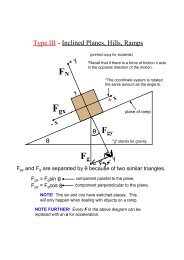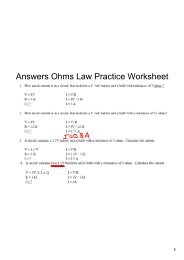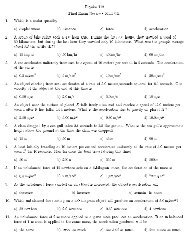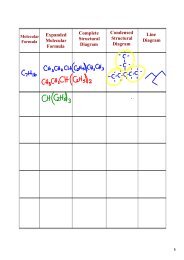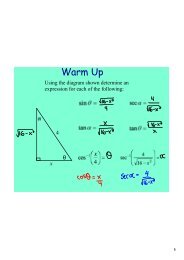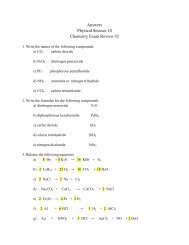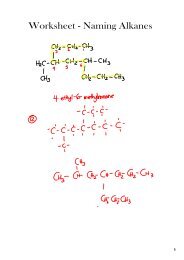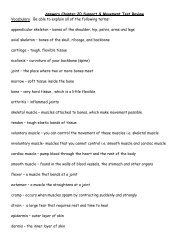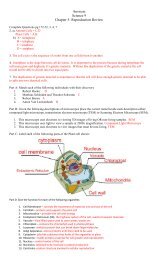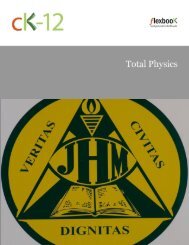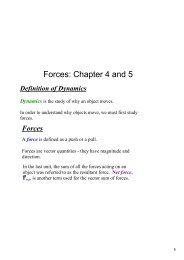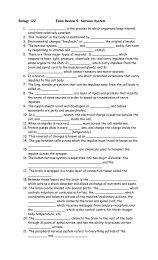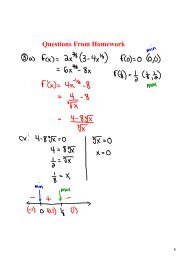Physics Study Guides.pdf - James M. Hill Memorial High School
Physics Study Guides.pdf - James M. Hill Memorial High School
Physics Study Guides.pdf - James M. Hill Memorial High School
You also want an ePaper? Increase the reach of your titles
YUMPU automatically turns print PDFs into web optimized ePapers that Google loves.
Wave OpticsBig Picture<strong>Study</strong> <strong>Guides</strong>Visible light is one type of electromagnetic (EM) radiation and only represents a tiny portion of the whole EM spectrum.All electromagnetic radiation is transferred by waves that can interact with each other. Wave optics mainly has to dowith the how these waves will interfere with each other. While we modeled light as rays in geometric optics, we will bedealing with how light behaves as a wave in this study guide.Key Terms<strong>Physics</strong>Disclaimer:Amplitude: In wave optics, the amplitude of an electromagnetic wave is the intensity of the wave.Interference: When two waves of the same type meet, they combine to create a larger or smaller wave. For moreinformation on interference, see the Waves study guide.Interference Pattern: Pattern resulting from interference. Light interference patterns are alternating light (minima)and dark bands (maxima).Diffraction: Occurs when a wave hits an obstacle or a barrier.Fresnel Diffraction: An approximation that can be used to estimate propagation of waves when very close to anantenna emitting electromagnetic waves.Fraunhoffer Diffraction: An approximation that can be used to estimate the propagation of waves when very far froman antenna emitting electromagnetic waves.Resolving Power: The ability of a device to distinguish between different wavelengths in the electromagnetic spectrum.Doppler Effect: Describes an apparent change in wavelength because of the relative motion of the source of a waveand an observer.Light as a WaveLight has a dual nature:• In some situations, it is better to model light as particles called photons.• In other situations, it is better to model light as a wave. Light waves are electromagnetic waves, which containchanging electric and magnetic fields that are oriented in directions perpendicular to the direction of travel.Electromagnetic radiation is categorized by its wavelength, ranging from radio waves of wavelength 10 8 meters togamma rays of wavelength 10 -16 meters. Below is an illustration showing the divisions in the electromagnetic spectrum.Image Credit: Philip Ronan, CC-BY-SA 2.5In the case of visible light, the brightness of the light corresponds to the amplitude of the wave.InterferenceElectromagnetic waves can interfere constructively or destructively just like any other type of wave. However, it ispossible to create easily visible interference patterns with light (unlike other types of waves such as sound).Interference patterns are created any time that two light waves with the same wavelength reach the same point bytraveling along slightly different paths. If we observe the light waves interacting on a surface such as a screen or a wall,there will be places where the interference pattern is bright (constructive interference) and places where the pattern isdark (destructive interferences). There are many situations where this is possible, including when light passes througha thin film or multiple separated slits.Michelson InterferometerThe interferometer are used to split beams of light into different paths and then recombine them to create an interferencepattern. Michelson used his design for an interferometer to demonstrate how the speed of light remained constant inan accelerating reference frame.This guide was created by Christopher Addiego and Catherine Wu. To learnmore about the student authors, visit http://www.ck12.org/about/about-us/team/interns.Page 1 of 2v1.11.1.2011this study guide was not created to replaceyour textbook and is for classroom or individual use only.




